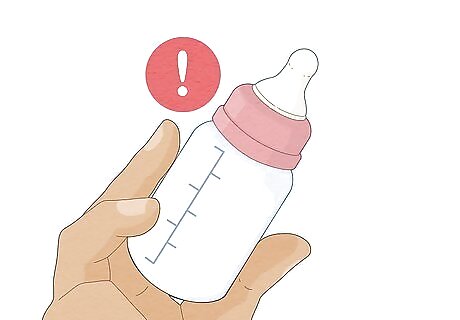
views
- Reduce confusion by not offering a bottle or pacifier to your newborn until they’re at least 4 weeks old.
- Breastfeed your baby as soon as they show signs of hunger to make feeding easier.
- Help your baby form good associations with feedings by singing to your baby, making eye contact, and cuddling with them.
Getting Baby Back to the Breast

Reduce the number of times you offer a pacifier or bottle. While trying to get back into breastfeeding, try feeding your baby from a bottle once or twice a day instead of for every feeding. To make it easier to switch back and forth, try using a round bottle nipple to mimic the feeling of a real breast.Tip: To prevent nipple confusion, give your newborn 2 to 4 weeks to master breastfeeding before introducing a pacifier or bottle. Using a slow flow bottle nipple or routinely taking the bottle out of your baby’s mouth between every 20-30 sucks (paced feeding) can simulate breastfeeding and help them switch between feeding methods, as well. Offer the breast or a finger instead of a pacifier whenever it seems like the baby wants to suck.

Breastfeed your baby when they start to show hunger cues. When babies are very hungry they often get upset, which makes breastfeeding more challenging. Try to breastfeed your baby as soon as you notice any of these common hunger cues: Sucking their fist or fingers Waking from sleep Fussing but not crying Waving their arms

Express a little milk before offering the breast to your baby. If your baby is used to the fast, immediate flow of milk that comes from a bottle, they may get frustrated while breastfeeding. Manually express or use a pump so your milk lets down before letting your baby latch so they're immediately rewarded with milk. If you can, try manually expressing milk directly into your baby's mouth so they're eager to nurse. If you’re unable to express milk, try dripping a little bit of water on your breast so that it goes into your baby’s mouth.

Adjust your breastfeeding positions. To make it easier for your baby to nurse, lie back with your baby on you so you're tummy to tummy, which makes them feel more supported and can make feeding easier. Try different breastfeeding positions until you find the ones that your baby prefers. If it's more comfortable, try the cradle hold where you lay the baby horizontally in front of you while supporting their body.#*Some babies are uncomfortable being held while feeding, and prefer being in a sling.

Check your baby's latch to ensure they're sucking effectively. Bring your baby to your breast when their mouth is wide open so they’re able to take more of the areola in their mouth. If the baby's latch is good, you'll soon hear swallowing. To encourage a good latch, hold your baby somewhat upright, support their head, and align their nose with your nipple. Tilt their head back and pull them in quickly and gently when they open their mouth. Try to get more of your areola pressing against their chin than their nose. If breastfeeding is painful, take the baby off of your breast and try to latch again.
Improving Your Breastfeeding Relationship

Spend more time skin-to-skin with your baby. Skin-to-skin contact has been shown to improve breastfeeding, help calm down your baby, and can improve parent-baby bonding. Cuddle up with your baby as often as you can to encourage them to breastfeed. Babies often like to suck while they’re sleepy or sleeping, so keep your breasts uncovered if you sleep next to your baby to encourage breastfeeding. Consider wearing your baby in a sling during the day so they're constantly connected with you. This feeling of closeness can relax them so they're calmer during nursing sessions.

Relax and stay calm when it's time to nurse. Your baby may feel anxious if you are stressed about breastfeeding. Take time before the nursing session to relax and unwind. This can also make your milk letdown easier. To help yourself feel calm, you could: Practice deep breathing Meditate Play soothing music Breastfeed in a quiet, dim room

Be patient and give your baby time to re-establish breastfeeding. Give your baby at least 1 or 2 days to become comfortable with breastfeeding again. Remind yourself that your baby is developing breastfeeding skills and may need time to get used to the change.Tip: Ask for extra help from family or friends so you can focus on feeding your baby. For example, see if a relative can come over and watch your older children or bring your family a meal.

Praise your baby every time they show improvement. Although babies can’t speak yet, they can follow your facial expressions and tone when you're close to them. If your baby has a good latch on or attempts to breastfeed, say, "Good baby!" and smile widely. Be consistent and give verbal praise frequently as your baby attempts to breastfeed. Making eye contact with your baby and speaking to them during breastfeeding can make them feel comfortable and form good associations with feeding.

Reach out for support if your baby still fusses after 3 or 4 days. If you've spent several days trying to improve your breastfeeding relationship but your baby is still struggling, contact a lactation consultant. They can offer specialized support, show you different breastfeeding positions, and determine if your baby is getting enough nutrition. Ask your hospital, birth center, or midwife if a lactation consultant is available to work with you.



















Comments
0 comment